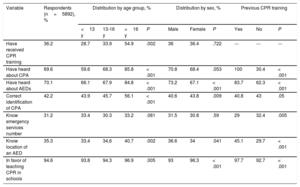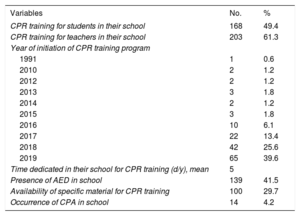Out-of-hospital cardiac arrest (OHCA) is one of the leading causes of premature death. Despite efforts to improve OHCA prognosis, survival rates remain low, at about 8%.1
Because measures such as high-quality chest compressions and early defibrillation increase survival, bystander cardiopulmonary resuscitation (CPR) can improve prognosis. Although the average bystander CPR rate is 58%, it varies widely among European countries (13%-82%).2
The recent European guidelines on CPR,1 which include the previous recommendations of the European Resuscitation Council and the International Liaison Committee on Resuscitation and the Kids Save Lives campaign, strengthen the need to teach CPR in schools and support its effectiveness, and the related legislation has thus been adopted in various European countries. In Spain, with more than 6 million students, the legislation stipulates that first aid training be given in primary schools.3 However, there is no plan for CPR training.
Via the CPR Working Group of the Spanish Society of Cardiology (SEC), a descriptive cross-sectional study was conducted using 2 nonstandardized questionnaires. These questionnaires were developed by expert consensus due to a lack of validated questionnaires in the literature; the first was designed to determine the degree of CPR understanding of 10- to 18-year-old students, while the second was designed to elucidate the degree of implementation of CPR training by the principals of these schools. After receiving the contact details of the schools interested in participating, provided by some autonomous communities when the education ministries were consulted on various occasions by the SEC in person or by email, we sent the schools direct links to both online questionnaires. Between February and June 2019, the questionnaires were completed anonymously on the SEC website. The results were directly uploaded for ad hoc analysis with SPSS version 20 (IBM, United States). The study was approved by the SEC and anonymity was guaranteed, given that the questionnaires requested no personal information beyond age.
Responses were received from 10 of the 14 autonomous communities that wished to participate; most responses (64.9%) were from Catalonia, mainly from Girona and Barcelona. After the exclusion of 395 forms due to completion failures, 5892 valid questionnaires from students were analyzed, as well as 343 from principals.
Participation was similar in boys and girls (P=.7) and the mean participant age was 14.7±1.92 years (table 1). In total, 69.6% of the students had heard about cardiopulmonary arrest (CPA), with no differences by sex (70.8% of boys and 68.4% of girls; P=.053) and with the percentage increasing with age (59.6% of those aged < 13 years, 68.3% of those aged 13-16 years, and 85.8% of those aged > 16 years; P ˂ .001). Notably, 70.1% had heard about automated external defibrillators (AEDs) and 35.3% knew the location of the nearest AED, a percentage that increased with age (33.4% of those aged < 13 years, 34.6% of those aged 13-16 years, and 40.7% of those aged > 16 years; P=.002). Only 31.2% knew the correct telephone numbers for emergency services (112 and 061) (table 2).
Results of the survey of students regarding CPR knowledge/training
| Variable | Respondents (n=5892), % | Distribution by age group, % | Distribution by sex, % | Previous CPR training | |||||||
|---|---|---|---|---|---|---|---|---|---|---|---|
| <13 y | 13-16 y | >16 y | P | Male | Female | P | Yes | No | P | ||
| Have received CPR training | 36.2 | 28.7 | 33.9 | 54.9 | .002 | 36 | 36.4 | .722 | --- | --- | --- |
| Have heard about CPA | 69.6 | 59.6 | 68.3 | 85.8 | < .001 | 70.8 | 68.4 | .053 | 100 | 30.4 | < .001 |
| Have heard about AEDs | 70.1 | 66.1 | 67.9 | 84.8 | < .001 | 73.2 | 67.1 | < .001 | 83.7 | 62.3 | < .001 |
| Correct identification of CPA | 42.2 | 43.9 | 45.7 | 56.1 | < .001 | 40.6 | 43.8 | .009 | 40.8 | 43 | .05 |
| Know emergency services number | 31.2 | 33.4 | 30.3 | 33.2 | .081 | 31.5 | 30.8 | .59 | 29 | 32.4 | .005 |
| Know location of an AED | 35.3 | 33.4 | 34.6 | 40.7 | .002 | 36.6 | 34 | .041 | 45.1 | 29.7 | < .001 |
| In favor of teaching CPR in schools | 94.6 | 93.8 | 94.3 | 96.9 | .005 | 93 | 96.3 | < .001 | 97.7 | 92.7 | < .001 |
AED, automatic external defibrillator; CPA, cardiopulmonary arrest; CPR, cardiopulmonary resuscitation.
Results of the survey of school principals (n=343)
| Variables | No. | % |
|---|---|---|
| CPR training for students in their school | 168 | 49.4 |
| CPR training for teachers in their school | 203 | 61.3 |
| Year of initiation of CPR training program | ||
| 1991 | 1 | 0.6 |
| 2010 | 2 | 1.2 |
| 2012 | 2 | 1.2 |
| 2013 | 3 | 1.8 |
| 2014 | 2 | 1.2 |
| 2015 | 3 | 1.8 |
| 2016 | 10 | 6.1 |
| 2017 | 22 | 13.4 |
| 2018 | 42 | 25.6 |
| 2019 | 65 | 39.6 |
| Time dedicated in their school for CPR training (d/y), mean | 5 | |
| Presence of AED in school | 139 | 41.5 |
| Availability of specific material for CPR training | 100 | 29.7 |
| Occurrence of CPA in school | 14 | 4.2 |
AED, automatic external defibrillator; CPA, cardiopulmonary arrest; CPR, cardiopulmonary resuscitation.
In addition, 36.2% had received CPR training, with a similar distribution by sex and an increase with age (< 13 years, 28.7%; 13-16 years, 33.9%; and > 16 years, 54.9%; P=.002).
Less than half of the sample (42.2%) knew that the theoretical criteria for identifying CPA are unconsciousness and lack of breathing, whereas 46.9% believed that pulse palpation was necessary.
Strikingly, of students with CPR training, only 29% knew the telephone number for emergency services and 40.8% correctly knew how to identify CPA.
Regarding principals, 343 responses were received. Half of the schools (49.4%) had offered CPR training to students, with no information on the time frame, and 61.3% to teachers at some time, but only 15.9% of the schools had a structured program within school hours. Just 29.7% of schools had material for teaching CPR, although 41.5% had an AED. Finally, 91.6% of principals and 94.5% of students were in favor of teaching CPR in schools. In addition, 4.2% of principals reported that there had been a sudden cardiac death in their school. For the indicated dates, between 1990 and 2018, there was no information on the event and the name of the school was not recorded in the questionnaire to protect anonymity.
This the largest study to date on knowledge of CPR in the school-age population. Although the data obtained provide a fragmented image of Spain, we can draw the following conclusions: a) only 36.2% of students reported having received CPR training, a lower number than in other studies, such as 89% in Norway,4 86% in North Carolina (United States),5 and 51% in Toronto (Canada)6; b) in Spain, where the legislation stipulates first aid training in schools, just 49.4% of principals stated that CPR was taught in their schools and only 15% of schools had a CPR training program; and c) less than half of survey respondents knew how to correctly recognize a CPA, at least in theory, and this was not affected by previous teaching.
A major limitation of the present study is related to the considerable heterogeneity in autonomous community participation, despite extensive effort to obtain a more representative sample. It is highly probable that there is a nonresponse bias that undermines even further the representativeness of the work regarding the rest of the country. In addition, the questionnaire was developed ad hoc, due to the lack of validated questionnaires for this purpose.
FUNDINGThis work has not received funding.
AUTHORS’ CONTRIBUTIONSJ. Bañeras and P. Jorge-Pérez conceived and designed the study. J. Bañeras and A. Lukic Otanovic analyzed the data. All authors have contributed to the data collection, interpretation, and article drafting.
CONFLICTS OF INTERESTNo conflicts of interest.


